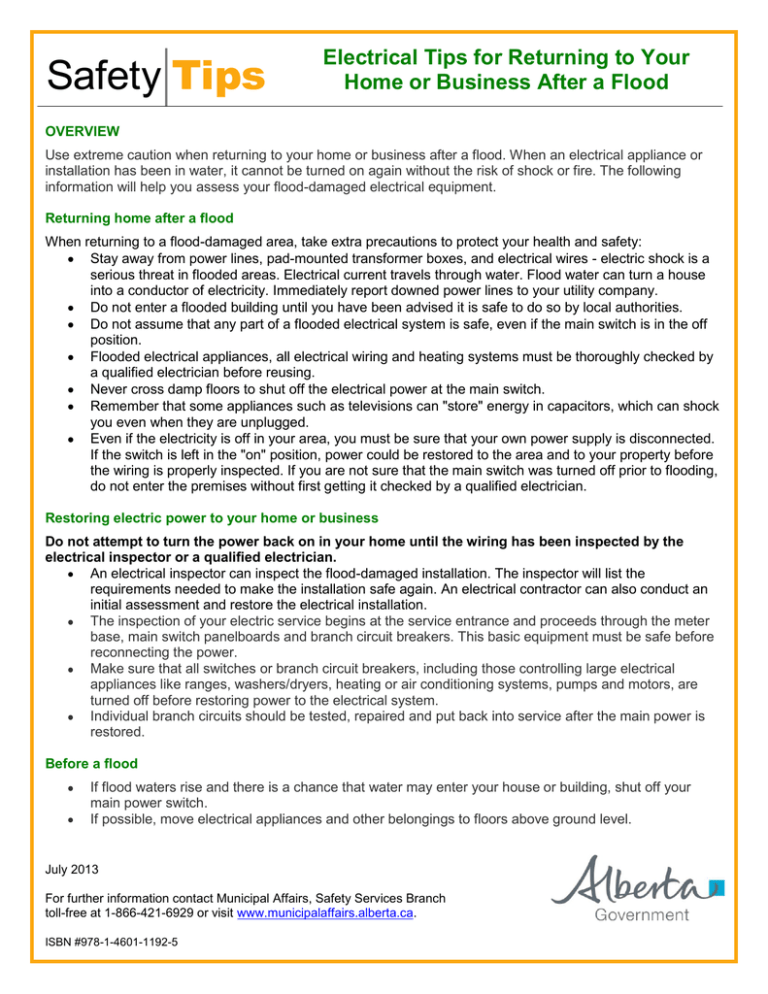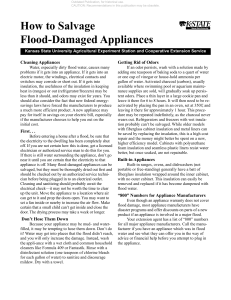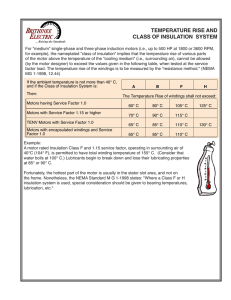Electrical Tips for Returning to Your Home or Business After a Flood
advertisement

Safety Tips Electrical Tips for Returning to Your Home or Business After a Flood OVERVIEW Use extreme caution when returning to your home or business after a flood. When an electrical appliance or installation has been in water, it cannot be turned on again without the risk of shock or fire. The following information will help you assess your flood-damaged electrical equipment. Returning home after a flood When returning to a flood-damaged area, take extra precautions to protect your health and safety: Stay away from power lines, pad-mounted transformer boxes, and electrical wires - electric shock is a serious threat in flooded areas. Electrical current travels through water. Flood water can turn a house into a conductor of electricity. Immediately report downed power lines to your utility company. Do not enter a flooded building until you have been advised it is safe to do so by local authorities. Do not assume that any part of a flooded electrical system is safe, even if the main switch is in the off position. Flooded electrical appliances, all electrical wiring and heating systems must be thoroughly checked by a qualified electrician before reusing. Never cross damp floors to shut off the electrical power at the main switch. Remember that some appliances such as televisions can "store" energy in capacitors, which can shock you even when they are unplugged. Even if the electricity is off in your area, you must be sure that your own power supply is disconnected. If the switch is left in the "on" position, power could be restored to the area and to your property before the wiring is properly inspected. If you are not sure that the main switch was turned off prior to flooding, do not enter the premises without first getting it checked by a qualified electrician. Restoring electric power to your home or business Do not attempt to turn the power back on in your home until the wiring has been inspected by the electrical inspector or a qualified electrician. An electrical inspector can inspect the flood-damaged installation. The inspector will list the requirements needed to make the installation safe again. An electrical contractor can also conduct an initial assessment and restore the electrical installation. The inspection of your electric service begins at the service entrance and proceeds through the meter base, main switch panelboards and branch circuit breakers. This basic equipment must be safe before reconnecting the power. Make sure that all switches or branch circuit breakers, including those controlling large electrical appliances like ranges, washers/dryers, heating or air conditioning systems, pumps and motors, are turned off before restoring power to the electrical system. Individual branch circuits should be tested, repaired and put back into service after the main power is restored. Before a flood If flood waters rise and there is a chance that water may enter your house or building, shut off your main power switch. If possible, move electrical appliances and other belongings to floors above ground level. July 2013 For further information contact Municipal Affairs, Safety Services Branch toll-free at 1-866-421-6929 or visit www.municipalaffairs.alberta.ca. ISBN #978-1-4601-1192-5 Safety Tips Electrical Tips for Returning to Your Home or Business After a Flood Page 2 Safety tips for cleaning up in damp or wet locations Electricity and water do not mix. To reduce the safety hazards associated with operating electrical equipment in damp or wet locations, use a ground fault circuit interrupter (GFCI) to help prevent electric shock injuries. Portable GFCIs, which are available from $20 to $30, can protect you from shock hazards when operating wet/ dry vacuum cleaners or other clean-up equipment. Never remove or bypass the ground pin on a three-pronged plug or use a non-grounded outlet. Remember to disinfect all flooded surfaces to kill the bacteria carried by the flood waters. If you can, wear gloves and boots to prevent direct contact with flooded areas. Don't forget to disinfect the insides of flooded appliances like your washer and dryer. Reconditioning flooded electrical equipment and appliances Do not plug in or attempt to use electrical appliances that have been wet until they are serviced or checked by an electrician or service agency. Most flood damage to electrical appliances will be from wet motor windings, wet insulation, rusting of metal parts and silt or dirt in switches, contacts and other moving parts. Contact the manufacturer or dealer you purchased the appliance from for the nearest service location. Guide to servicing your electrical equipment Electrical Equipment Servicing Recommendation Appliance or extension cords If an appliance or extension cord has been wholly or partially immersed in water and shows signs of insulation damage after being thoroughly dried out, replace the cord. Appliances: small electrical Thoroughly clean and dry the appliance before using it. If the appliance contains an electric motor, see Motors section on page 4. Controls may be corroded and inoperative, making the appliance unusable. In many cases purchasing a new appliance may be more economical than servicing lt. Clocks: electric Water and silt can damage precision bearings and clock parts servicing by a repair shop is recommended for lasting operation. Electrical services and distribution panels All electrical service equipment should be inspected and serviced by an electrical contractor or qualified electrical equipment servicing agency who will open, clean and thoroughly dry the equipment. Electric circuit breakers, GFCIs, and fuses that have been submerged must also be replaced. Water and silt inside the devices can prevent them from performing properly as safety devices and can cause electrical shorts or mechanical malfunctions. The only safe action is to discard and replace the device. Electronic components: stereos, radios and computers Internal components of most electronic equipment will be severely damaged by submersion in water. Rust, corrosion and dirt contamination of components and connections may leave the equipment unserviceable. Motors and power supplies will require servicing or replacement. Consult a service agency for an assessment and estimate for repairs as soon as possible, as corrosion in the equipment will continue if the components are not thoroughly dried out immediately. Purchasing a new unit may be the safest and least expensive alternative. Farm equipment: brooders and incubators Dismantle and thoroughly dry the box or cabinet. Replace insulation and internal wiring if it shows any signs of deterioration. Clean or replace thermostats. Treat fans as described under the Motors section. Treat electrical elements as described under Heating and cooking equipment. Have an electrician check all livestock electric heating units before use. Farm equipment: milking machines Treat the motor as described under Motors. Flush out and sterilize all piping and lines. Service the pump assembly as described under Water systems. ISBN #978-1-4601-1192-5 Safety Tips Electrical Equipment Farm equipment: time clocks and controls Heating and cooking equipment Electrical Tips for Returning to Your Home or Business After a Flood Page 3 Servicing Recommendation Treat as noted under Clocks. The main damage to an electric range will be soaked insulation and water-damaged switches and controls. Semi-enclosed elements may also be damaged. Electric heaters with sealed elements can be cleaned and dried out. Thermostats may require replacement. Your range should be thoroughly checked out by your appliance service agency. Discuss the following points: The switches and controls on electric ranges are difficult to dry out and may break down over time. Replacement may be necessary. The oven control may also fail due to moisture in the insulation. Newer ranges will have sealed surface elements, which will not absorb moisture. Semienclosed elements may have absorbed moisture and will require replacement. Depending on the type and condition of the insulation on the internal wiring, proper drying out of the appliance may be all that is necessary. Your service agency can advise you of necessary repairs Motors: electric Refrigerators, freezers, air conditioners and refrigeration equipment Without proper servicing, do not use any appliance with a motor that has been wet. An electric motor that shows signs of being wet should be completely serviced before being used. Moisture that has entered the windings can cause the motor to short out and fail. This can present a shock or fire hazard. Dirt or silt in the bearings will cause premature bearing failure. This work should be done by a motor repair or rewinding shop. The rehabilitation of a flood-damaged motor will include: dismantling, cleaning, baking of the windings to remove moisture, re-assembly, re-oiling of bearings, and testing. Refrigeration equipment can be classified into two types: belt-driven with exposed motor, and thematically sealed units The unit should be properly inspected and serviced by an appliance service agency, who will consider the following: Any refrigerator cabinet that has been even partially immersed in water will have wet Insulation. The cabinet will have to be opened up and Insulation dried or replaced. Open-type motors will require servicing or replacement (see the Motors section). Thematically sealed units will probably not be damaged and can be cleaned and re-used. Check controls, relays and wiring for damage Washers and dryers Treat the motors and controls as noted under the Motors and Heating and cooking equipment sections. The gear box on most washers is sealed, but should be checked to see that water has not contaminated the lubricating oil or grease. Flush out the box with solvent, thoroughly clean, re-grease and reassemble the unit. Treat the pump as noted under Water systems. Remove all water and silt from bearings and other moving parts. Check the electric element in the dryer for moisture damage. Water heaters Replace any wet or damp insulation. Check the wiring within the water heater and replace it if there are any signs of deterioration. Check and clean thermostats and heating elements. Water systems: motor Treat the pump motors as noted under the Motors section. Water systems: pump mechanism If the pump mechanism is not a sealed unit, check for water and silt contamination. If it is contaminated, dismantle the pump, clean it and add fresh oil Clean the inlet screen on the suction valve. Do not drain off old, contaminated oil until you are ready to clean and replace it, otherwise interior pump parts may rust. Water systems: foot valve If the pump has a foot valve and screen, clean, flush and reinstall it before operating the reconditioned pump. ISBN #978-1-4601-1192-5 Safety Tips Electrical Equipment Electrical Tips for Returning to Your Home or Business After a Flood Page 4 Servicing Recommendation Water systems: pressure switch and controls Service the pump controls as noted under Electrical service and distribution panels. Telephones and telephone equipment Contact your telephone system supplier for assistance in assessing damage to the telephone system in your building. Treat telephones themselves as noted under Appliances: small. Vacuum cleaners Treat the vacuum as noted under Appliances: small and Motors. Take safety precautions in operating vacuums in wet locations (see Safety tips on page 2). ISBN #978-1-4601-1192-5







